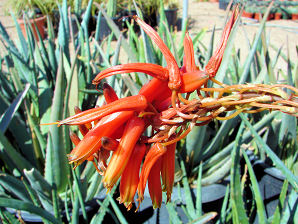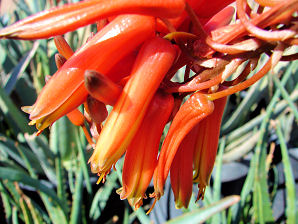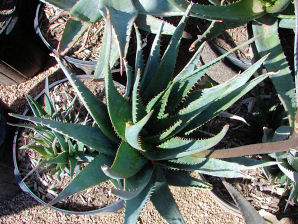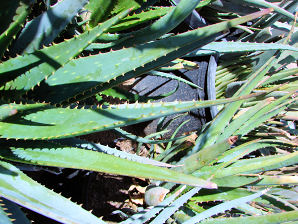Xeriscape Landscape Plants & Flowers
For The Arizona Desert Environment.
Pictures, Photos, Images, Descriptions, & Reviews.
Torch Aloe, Aloe arborescens.
We Are Proud Of Our SafeSurf Rating!
Click On Any Of The Following Links By Amazon.Com
For Books, & Videos About Wildflowers Of Arizona & The Southwest USA. No Obligation!
 |
| Torch Aloe, Aloe arborescens. Photos Taken At Phoenix Desert Nursery. March 3, 2008. |
|---|
 |  |
| Torch Aloe. Aloe arborescens. | Torch Aloe. Aloe arborescens. |
|---|---|
 |  |
| Torch Aloe. Aloe arborescens. | Torch Aloe. Aloe arborescens. |
Torch Aloe.
We wish to thank Wikipedia, the free encyclopedia for some of the information on this page. We share images and information with Wikipedia. Aloe arborescens: A large densely growing succulent growing to about 9 feet tall with an equal spread. It has several 18 inch wide rosettes of narrow recurved, soft toothed, margined, slightly concave leaves that are from a dull green to yellowish color. Sometimes they are blue -green in color. Their cylindrical orange to coral - red flowers hang tightly on an unbranched inflorescencse that rises about 2 feet above the foliage in the late fall and early winter. It does well in full sun to light shade. This drought tolerant plant is hardy to about 22 degrees F. Torch Aloe is next only to Aloe vera in its healing and medicinal qualities. The clear gel-like sap that oozes from cut aloe leaves has been shown to help burns and wounds heal faster and to reduce the risk of infection. It is very pool friendly. But, it can grow tall.
Quick Notes:
Height: Height to about 9 feet. Spreading to about 9 feet.
Flowers: Cylindrical orange to coral - red drooping flowers grow in a long raceme at the top of the flower stalk. On an inflorescence that is branched into 3 to 8 racemes, the racemes sre 8 inches to 16 inches in length. Flowers are 1 inch - 1 1/4 inch in length, tubular in shape and slightly upturned at the mouth.
Flowering Time: Phoenix Arizona, January - July.
Fruit: The fruit is a triangular capsule containing numerous seeds.
Stems: Stemless, densely leaved rosette.
Leaves: Smooth dull green to yellowish in color, narrow recurved, soft toothed, margined, slightly concave.
Found: Native to Africa, south western Asia and Madagascar.
Hardiness:
Soil pH requirements:
Sun Exposure:
Elevation: 0 - 4,800 feet. In Arizona.
Habitat: Sandy or gravelly, well-drained soil. Partial Sun. Best with some shade. A Xeriscape Landscape plant.
Miscellaneous: Maintenance: Low. Photos Taken At Phoenix Desert Botanical Garden. March 3, 2008.
|
We Are Proud Of Our SafeSurf Rating!
Click On Any Of The Following Links By Amazon.Com
For Books, & Videos About Wildflowers Of Arizona & The Southwest USA. No Obligation!
| © 1966 - Present, Audrey, Eve, & George DeLange |
